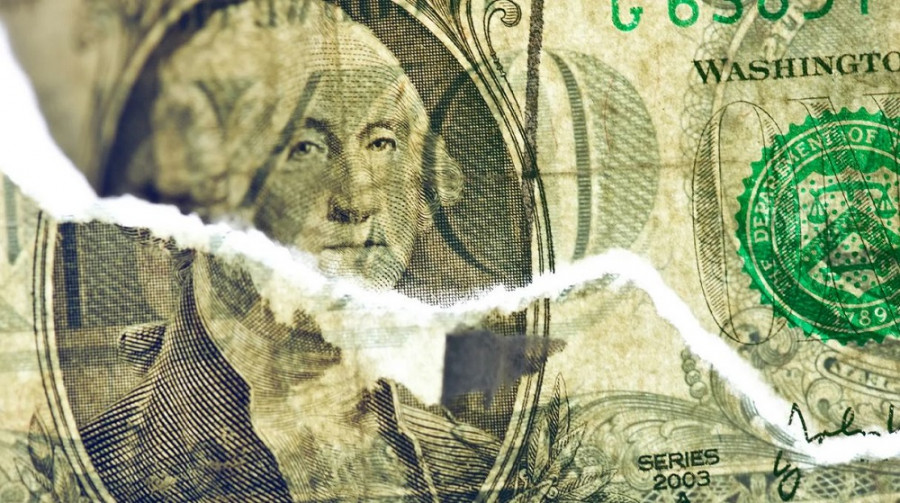
The euro-dollar pair started the new trading week by declining towards the base of the 5th figure, reacting to the rise in risk-off sentiment. However, by the end of yesterday, EUR/USD buyers had recovered almost all the lost positions. Today, the upward momentum continues, and the pair is testing the 6th figure, despite the ongoing tension in the Middle East. Traders of the pair find themselves caught between a rock and a hard place. On one hand, geopolitical factors favor the safe-haven dollar. On the other hand, cautious comments from the Federal Reserve are putting pressure on the greenback ahead of key U.S. inflation data releases. After some fluctuations, the scales have tilted in favor of EUR/USD buyers.

Recent events have shown that the dollar is highly responsive to verbal interventions from the Fed. However, the problem lies in the fact that Fed members are not unanimous in their views on the future prospects of monetary policy tightening. Following a series of hawkish statements (which significantly strengthened the greenback), the dollar bulls received a cold shower in the form of cautious comments from representatives of the "dovish wing" of the Fed.
It's worth noting that some Fed members are reconsidering their positions toward a more dovish stance. For example, Cleveland Fed President Loretta Mester stated that the Fed is likely to have to raise rates again this year because inflation risks are currently tilted to the upside. Federal Reserve Governor Michelle Bowman voiced a similar position. According to her, she is ready to support a rate hike at the November meeting "if published data show that progress in reducing inflation has stalled or is proceeding too slowly."
However, more cautious and even "dovish" comments followed from some colleagues of Mester and Bowman. For example, Mary Daly, the president of the San Francisco Fed, stated that there is no need for further tightening of the Fed's policy, given the recent rise in U.S. Treasury yields. Former Dallas Fed President Rob Kaplan agreed with her, noting that the need for a rate hike, at the moment, is less. In his view, the rate will reach its target as long as it remains at its current level "for an extended period." However, he also noted that progress on inflation is encouraging, although it's still "too early" to say that inflation is steadily heading toward the two percent target.
Federal Reserve Vice Chair Philip Jefferson shares the same sentiment. According to him, the U.S. regulator will need to "proceed very carefully" given the recent rise in yields. He emphasized that the regulator should remember the worsening financial conditions due to rising Treasury yields and take this factor into account when assessing the future trajectory of monetary policy.
It's worth noting that some Fed members are shifting toward a more dovish stance. For example, Mester had a more hawkish stance—she insisted on tightening monetary policy, citing high inflation levels. However, amid a drop in the core PCE index (to 3.9%) and a slowdown in average wage growth (4.2%), Mester significantly softened her rhetoric, leaving the "hawkish wing" of the Fed.
Market hopes for a hawkish stance have also diminished significantly. Last week (before the Nonfarm Payrolls release), the probability of a 25-point rate hike at the November meeting was over 40% (according to the CME FedWatch Tool). As of today, this probability is only 12%. This is a serious blow to the positions of the American currency. If the inflation reports, to be published at the end of this week, do not fall in the "green zone," the dollar will face additional pressure. After all, the prospects for December are also in question (currently, the probability of a rate hike in December is almost 30%).
The events in Israel have provided only short-term support to the greenback, as this conflict, despite its tragic and deadly nature, remains regional for now. That's why American stock indices rose after starting in the red on Monday. For instance, the Dow Jones Industrial Average index rose by 0.60%, the Standard & Poor's 500 by 0.63%, and the Nasdaq Composite by 0.39%.
Geopolitical fundamental factors can provoke strong volatility but are rarely able to keep markets on edge for an extended period. However, each case is unique. If Israel decides to conduct a ground military operation in the Gaza Strip, events may unfold according to a scenario of further escalation. Predicting the consequences of such a step is very difficult, given the previous statements of many key regional players. Therefore, it is too early to write off the dollar—it may soon make a comeback, as the situation is changing dynamically.
However, if we abstract from geopolitics, the overall fundamental backdrop does not favor the U.S. currency. Fed members doubt the necessity of rate hikes, and recent macroeconomic releases (core PCE index, pro-inflationary Nonfarm indicator) allow them to express such doubts. All these factors are not in favor of the greenback, allowing EUR/USD buyers to go on the counteroffensive.
Currently, the EUR/USD pair is testing the middle line of the Bollinger Bands indicator on the D1 timeframe (1.0600). Considering long positions is advisable only if buyers overcome this target and establish themselves above it. Note that this is not the first attempt to breach the 6th figure in recent times—all previous attempts failed. Therefore, caution is necessary here. If EUR/USD bulls still manage to overcome this price barrier, the next target for the upward movement will be the 1.0700 level, which corresponds to the Tenkan-sen line on the W1 timeframe. Overall, the situation remains uncertain, as the classical fundamental factors are accompanied by the notorious geopolitics—volatile and unpredictable.